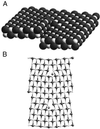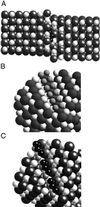Organic protomolecule assembly in igneous minerals
- PMID: 11226206
- PMCID: PMC30106
- DOI: 10.1073/pnas.061513298
Organic protomolecule assembly in igneous minerals
Abstract
CH stretching bands, nu(CH), in the infrared spectrum of single crystals of nominally high purity, of laboratory-grown MgO, and of natural upper mantle olivine, provide an "organic" signature that closely resembles the symmetrical and asymmetrical C--H stretching modes of aliphatic -CH(2) units. The nu(CH) bands indicate that H(2)O and CO(2), dissolved in the matrix of these minerals, converted to form H(2) and chemically reduced C, which in turn formed C--H entities, probably through segregation into defects such as dislocations. Heating causes the C--H bonds to pyrolyze and the nu(CH) bands to disappear, but annealing at 70 degrees C causes them to reappear within a few days or weeks. Modeling dislocations in MgO suggests that the segregation of C can lead to C(x) chains, x = 4, with the terminal C atoms anchored to the MgO matrix by bonding to two O(-). Allowing H(2) to react with such C(x) chains leads to [O(2)C(CH(2))(2)CO(2)] or similar precipitates. It is suggested that such C(x)--H(y)--O(z) entities represent protomolecules from which derive the short-chain carboxylic and dicarboxylic and the medium-chain fatty acids that have been solvent-extracted from crushed MgO and olivine single crystals, respectively. Thus, it appears that the hard, dense matrix of igneous minerals represents a medium in which protomolecular units can be assembled. During weathering of rocks, the protomolecular units turn into complex organic molecules. These processes may have provided stereochemically constrained organics to the early Earth that were crucial to the emergence of life.
Figures






References
-
- Freund F, Gupta A, Kumar D. Origins Life Evol Biosphere. 1999;29:489–509. - PubMed
-
- Freund F, Ho R. In: Circumstellar Habitable Zones. Doyle L R, editor. Menlo Park, CA: Travis House; 1996. pp. pp.71–98.
-
- Butler C T, Sturm B J, Quincy R B. J Cryst Growth. 1971;8:197–204.
-
- Gupta A, Freund F. Lunar & Planetary Science Conference. Vol. 29. Houston, TX: Lunar & Planetary Institute; 1998.
-
- McCollom T M, Ritter G, Simoneit B R T. Origins Life Evol Biosphere. 1999;29:153–166. - PubMed
LinkOut - more resources
Full Text Sources
Research Materials

